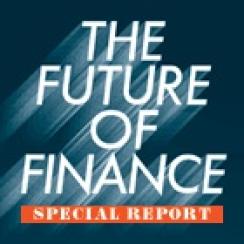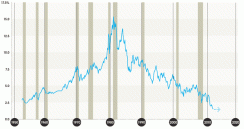
In many ways, it was a routine day for the world’s most powerful economic policymaker. The Fed has exerted a paramount influence over the economy and financial markets since Paul Volcker broke the back of inflation with his determination and high interest rate policies in the early 1980s. His successor, Alan Greenspan, steadied the economy after the 1987 stock market crash by flooding markets with liquidity, helped insulate the U.S. economy from the Asian financial crisis in the late ’90s and cut rates aggressively to stimulate growth after the dot-com bust in 2000. Bernanke himself has given considerable credit to Fed policy for fostering the Great Moderation, the lengthy period of low volatility, sustained growth and restrained inflation that prevailed before the crash.
Yet today the promise of fresh easing by the Fed may do little to alter the fundamental outlook. Ever since the subprime mortgage crisis erupted in 2007, the Fed has taken increasingly bold action in a bid to keep financial markets functioning and the economy growing. In December 2008 the central bank for the first time in its 99-year history slashed its target for the federal funds rate, the key rate it uses to steer the economy, to zero. Unable to lower rates further, the Fed then employed a series of unconventional policies —

Since the recession ended in the middle of 2009, the U.S. economy has grown at a rate of 2.2 percent a year, barely half the 4.2 percent average for postwar rebounds. The economy has regained only 4 million of the 8.8 million jobs lost during the downturn, and the unemployment rate stands at 8.3 percent, at least 2 percentage points above the level that Fed officials consider to be full employment. Recoveries in Europe and Japan have been even weaker, although their central banks have pursued similarly ambitious policies.
As a result, the Fed — and by extension most major central banks in the advanced economies — faces potentially the greatest dilemma in its history: the exhaustion of monetary policy. For policymakers and investors long accustomed to viewing central bankers as omnipotent, it’s a nightmare scenario that would see the U.S. and Europe, stuck in a liquidity trap with policy rates at or near zero, condemned to the kind of prolonged stagnation that Japan has suffered for much of the past two decades. Such a dire outcome isn’t guaranteed, but even in the best of circumstances, many policymakers, economists and money managers are coming around to the view that today’s historically low interest rates and subdued economic activity could persist for many years.
Bernanke and his team can launch another round of QE or adopt one or two other as-yet-untried nontraditional policies, but they can’t be sure such efforts will have any real traction in the economy. Some economists have proposed that the Fed be more daring and temporarily relax its inflation target as the best way of lifting interest rates above the zero bound and getting the economy moving again, but Bernanke — along with almost all central bankers — rejects the idea as heresy. “It’s hard to see what buttons we can push to get the economy back to full employment in 2014,” Janet Yellen, the Fed’s vice chairman, conceded in an interview with Institutional Investor earlier this summer. “I think central bankers around the world are worried about their ability to do enough. We’re all wishing we had more tools.”
Vitor Constâncio, vice president of the European Central Bank, is equally blunt about the limits of his institution’s powers. In an interview in his 35th-floor office at the ECB’s Eurotower, with muffled shouts coming from the streets below as police disband a months-long encampment of Occupy Frankfurt protesters, Constâncio notes that the ECB has supplied ample liquidity to European banks with its €1 trillion ($1.26 trillion) in long-term refinancing operations in December and February. The central bank can also buy short-term government bonds to reduce spreads on the debt of countries such as Greece, Portugal, Spain and Italy. (Indeed, spreads narrowed last month in anticipation of a new bond-buying initiative by the central bank.) “Where monetary policy has more or less almost reached its limits is in contributing to jump-start the economy,” says Constâncio. “We offer almost zero interest rates. It has not led to a strong credit expansion. People are deleveraging. Households, firms, banks — everyone is deleveraging after the big bubble that preceded the crisis. In such an environment we have to endure a period of slow growth.”
Lars Svensson, deputy governor of Sveriges Riksbank, the Swedish central bank, offers a similarly sober view. “At the beginning of the crisis, we had no idea it would last so many years,” he says. “Who knows how many more years we will have close to zero rates. It could be quite a few.”
Bernanke isn’t about to throw in the towel and admit defeat. He gave a lengthy defense of the Fed’s unconventional policies in his Jackson Hole speech. Studies by economists both inside and outside the Fed have found that QE so far has lowered the yield on ten-year U.S. Treasuries by between 80 and 120 basis points, boosted economic output by almost 3 percent and generated more than 2 million private sector jobs, he noted. But he acknowledged that unconventional policies have potential costs as well as benefits, and he said the hurdle for doing things like more QE now is higher than it was in the past when the Fed was raising or lowering interest rates.
| Race to the Bottom Ten-Year Treasury Constant Maturity Rate (GS10) | |||

| |||
| Source: Board of Governors of the Federal Reserve System. | ||
Lacker’s skepticism of central bank activism is increasingly shared by the Bank for International Settlements, the Basel, Switzerland–based organization that works on behalf of the world’s central banks. “We’re overburdening central banks by expecting them to solve all of these problems,” says Stephen Cecchetti, chief economist at the BIS. “Central banks can’t solve structural problems.”
Political opposition to the Fed’s activism is increasing too. Republican presidential nominee Mitt Romney has vowed not to reappoint Bernanke, a Republican, if elected, and in July the House of Representatives approved a bill by Texas Republican Ron Paul that would subject the Fed’s monetary policy decisions to a congressional audit. “There’s such hostility to the Fed in Congress,” says Laurence Meyer, a former Fed governor and senior adviser at Washington-based forecasting outfit Macroeconomic Advisers. “You don’t want to give them additional meat that would give them a reason to do something to impinge on the independence of the Fed.”
Even financial markets are beginning to doubt the Fed’s effectiveness. A new round of quantitative easing could serve to increase pessimism about the economic outlook without driving already low long-term rates down even further. “If you take the position that these unconventional measures work, why would you go from QE1 to QE2 to QE3?” says David Blumer, chief investment officer at Swiss Re in Zurich. “I’m not sure that they really solve the problem at the root.” Steve Walsh, CIO of Western Asset Management Co., is equally skeptical. “I don’t think the Fed can do much more,” he says.
The U.S. and other advanced economies suffer from too little growth, too much debt and too much political polarization, which prevents governments from adopting optimal policies, says Mohamed El-Erian, CEO and co-CIO of Pacific Investment Management Co. “Central banks don’t have instruments to address these things,” he adds. “The only thing they can do is buy time.”
Considerable time is needed to address the deep-rooted problems plaguing most advanced economies in the aftermath of the largest credit bubble in recent history. Since 1800, financial crises that have caused a country’s debt to rise to 90 percent or more of GDP have depressed growth for more than two decades, on average, economists Carmen Reinhart, Vincent Reinhart and Kenneth Rogoff noted in their recent paper “Debt Overhangs: Past and Present.” Most of the work needed to dig out of a financial crisis must be done by political authorities, not central banks.
In the U.S. the most urgent priorities include reviving the moribund housing market and avoiding the so-called fiscal cliff. Prospects on both fronts are dubious at best. The Treasury recently proposed that Fannie Mae and Freddie Mac allow half a million underwater homeowners to write off some of the principal on their mortgages, only to have the overseer of the two housing agencies reject the idea. Republicans and Democrats have hardened their stances on fiscal issues ahead of the November presidential election, increasing the risk that the two sides will fail to strike a budget compromise before the end of the year. If they don’t, tax increases and spending cuts worth more than 4 percent of GDP are due to take effect at the start of 2013; most economists believe this would send the economy into reverse.
In his Jackson Hole speech, Bernanke pleaded for a fiscal compromise that would support the economy in the short term and bring down the deficit in the medium to long run. “Monetary policy cannot achieve by itself what a broader and more balanced set of economic policies might achieve; in particular, it cannot neutralize the fiscal and financial risks that the country faces,” he said. Former Fed governor Meyer is even blunter about the risks. “If we fall into recession, I can’t tell you how we get out. I just can’t,” he says. “This is a much more dangerous time than Lehman Brothers.”
For Europe the problems are even more daunting. The debt crisis has exposed fundamental flaws in the construction of the euro that threaten to force the breakup of the single currency. European Union leaders are trying to plug those gaps by creating a common support mechanism for the bloc’s banking industry, pursuing tough structural reforms to make their economies more productive and laying the groundwork for closer budgetary cooperation.
“We need to have a bank resolution authority, and later on we need to have European deposit insurance and we need a bigger dose of fiscal union,” says Constâncio. “Europe will never be one country, but we’ll have to deepen integration in fiscal policy, with more control from the center, beyond what has been proposed.” Fulfilling that agenda is a challenging task, however, at a time when unemployment is soaring in countries like Greece and Spain, and opposition to bailouts is mounting in countries like Germany and the Netherlands.
In the face of such deep-seated problems, many investors have given up hope that Western economies — and investment returns — will revert to their precrisis buoyancy any time soon.
Peter Fisher, head of fixed-income portfolio management at $3.3 trillion asset manager BlackRock, says the exceptional performance generated by bonds during the disinflationary period of 1982 to 2005 is history. “The long-run real return on capital is 2.5 percent,” he says. “If you’re really good, a really savvy investor, maybe you can double that.” One of the ways BlackRock is trying to add alpha is by building up its capital markets operation and working directly with borrowers to design bond offerings that suit its needs. “We’re going to have to work a bit harder at finding the right things to put in people’s portfolios,” says Fisher.
Swiss Re, which like many insurers invests most of its $150 billion portfolio in fixed-income securities, saw the running yield on its portfolio slip to 3.5 percent in the second quarter from 3.7 percent in the first because of the downward trend in rates. The company recently has been reducing its exposure to government bonds and increasing its holdings of corporate debt, emerging-markets sovereign debt, loans and infrastructure investments in a bid to boost returns, says CIO Blumer. “You have to find higher-yielding opportunities,” he adds. “There aren’t that many.”
Alan Brown, a senior executive at Schroders who recently stepped down as the U.K. fund management firm’s CIO, underscores the challenge facing investors. “This is fundamentally the most troubling environment in the 40 years I’ve been in this business,” he says.
There is no small irony in Bernanke’s dilemma. The former Princeton University economics professor made his mark as an authority on the Great Depression; he blamed the Fed’s tight money policies in the early 1930s for helping to cause that economic collapse. As an academic he accused the Bank of Japan of paralysis back in 2000 and urged it to use unconventional policies aggressively to stimulate the economy. And in his first stint as a Fed governor, nearly a decade ago, he argued that the central bank could remain effective even in a deflationary environment by pursuing quantitative easing or simply cranking up its printing press.
Life under the zero bound has proved more difficult than theory. When the Fed first cut rates to zero, in December 2008, the impact was blunted by concerns about the health of banks, whose lending transmits Fed policy to the economy at large, and about a possible upturn in inflation, which kept long-term rates relatively high. The Fed then managed to drive down long-term rates with its quantitative easing, but that hasn’t done much to stimulate demand for funds. As Charlie Bean, deputy governor of the Bank of England, puts it: “If you’re a business and your cost of capital goes down 100 basis points, you might think that’s neither here nor there. I’m more worried about whether there will be any demand at all tomorrow, particularly given concerns about the euro area.”
Many economists are concerned that a long period of low interest rates may cause more trouble than it’s worth. They cite fears about a misallocation of capital, pointing out that the Fed’s easy policies from 2001 to 2004 helped stoke the housing bubble. They also argue that low rates penalize savers and discourage a needed shift in the economy from consumption to investment and production.
“Can we really live in a world where interest rates are this low for a very long time?” says the BIS’s Cecchetti. “What are we doing to people’s incentives to lend? What are we doing to returns in the financial system that are supporting our future?” Fed officials acknowledge the negative impact of low rates on savers but insist that the positive effects of promoting growth and employment are more significant.
With interest rate policy maxed out, the Fed has purchased an unprecedented amount of Treasuries and agency bonds in two rounds of quantitative easing, shifted its portfolio toward long-term securities under Operation Twist and extended its interest rate guidance by one year, to late 2014. Those measures have clearly had an impact on long-term rates. The ten-year Treasury yield stood at 1.55 percent after Bernanke’s Jackson Hole speech, compared with 3.78 percent in November 2008, before the Fed announced its first round of bond buying. The economy, however, has continued to languish, weighed down by bank and household deleveraging, and fears about a debt implosion in Europe. The U.S. economy grew at an annual rate of just 1.7 percent in the second quarter, too slow a pace to bring down the unemployment rate.
In considering further action, Fed officials indicate they are focusing on two main options: extending the zero-rate guidance further, to 2015, and embarking on a third round of quantitative easing. Many economists believe extended guidance is a relatively easy call because it doesn’t require actual market intervention and can be reversed easily if the economy improves. Charles Evans, president of the Chicago Fed, has proposed what he calls a 7/3 threshold whereby the Fed would commit to not raise the federal funds rate until unemployment falls below 7 percent or inflation rises above 3 percent. But some Fed insiders are skeptical. Bernanke is due to step down in 2014, and a pledge to keep rates near zero until the following year would effectively bind his successor. Some at the Fed wonder if markets would regard such a promise as credible.
As for QE, there are signs of growing polarization inside the Fed. In addition to his recent policy dissents, the Richmond Fed’s Lacker has publicly stated that further bond purchases won’t help the economy. Richard Fisher, president of the Dallas Fed, has also criticized QE, although he doesn’t currently have a vote on the FOMC. On the other side, there is a sizable dovish contingent that includes Evans, Boston Fed president Eric Rosengren and William Dudley, president of the New York Fed. Rosengren has recently called for an open-ended commitment by the Fed to purchasing Treasuries and mortgage bonds.
Given those tensions, the Fed may well hold off on fresh action until the economic data is clearer. Bernanke in particular is believed to be reluctant to announce a politically controversial policy move in the midst of the presidential election; that could turn the Fed into even more of a political football. “We’re not unaware of what the political climate is,” says vice chairman Yellen. “Obviously, there’s a reasonable amount of concern about what the Fed has been doing. I think there’s a good deal of misunderstanding about what we’ve done and why we’re doing it. That’s understandable. But I think we’ve consistently tried to take decisions that we think are in the best interest of the country.”
Fed officials also need to consider the market’s view of their actions. Most investors study Fed statements closely for hints of whether or when the central bank will launch QE3, because of its ability to move asset prices. “The markets have become kind of hooked on QE,” says Chris Iggo, CIO for fixed income at AXA Investment Managers in London. “It’s the heroin of the financial markets.” Yet many investors see diminishing returns from successive rounds of bond purchases, considering how low rates are today. Some contend that QE3 could actually be bearish for markets, suggesting that the Fed is even more downbeat about the economy or serving as a harbinger of future inflation.
“It’s because interest rates are this low that we’re seeing this climate of fear,” says Anne Richards, CIO at Aberdeen Asset Management in London. “It seems to me there needs to be a game changer in terms of central bank policies. We can’t have a situation indefinitely where prudence is penalized in favor of less prudence.”
Bean of the Bank of England, which has been proportionally more aggressive than the Fed, buying £375 billion ($595 billion) worth of government bonds, is cognizant of the danger. “The potential issue that arises with QE is, when you’ve done so much of it, market participants start doubting your ability to reverse it sufficiently promptly,” he says. “They start thinking, ‘Well, ultimately, it’s going to lead to inflation.’ I don’t think we are anywhere near that point. But it’s important for us what market participants believe, because it would be very unhelpful for us if we did more QE and yields started rising.”
In a bid to sidestep QE’s shortcomings, the Bank of England last month launched a new initiative in conjunction with the U.K. Treasury to stimulate credit directly. The Funding for Lending program will provide cheap funds, at rates as low as 0.25 percent, to banks that maintain or increase their loans to small and medium-size enterprises. “It should reduce marginal funding costs by a bit more than 100 basis points, on average,” says Bean. “We would expect at least the majority of it to get passed through to loan rates to households and businesses.” It will take a few months to determine if the program, which Fed officials are watching with interest, improves the availability of credit to small businesses.
In contrast with the aggressive U.S. and U.K. approaches, the ECB is a reluctant buyer of bonds. Germany demanded that the Maastricht Treaty contain explicit provisions outlawing central bank financing of government deficits, which Berlin fears would fuel inflation. ECB officials insist that bond purchases under the bank’s Securities Market Program don’t represent quantitative easing; instead, they are designed to reduce excessive yield spreads among countries and ensure that the central bank’s policy rates are transmitted more evenly across the euro area. Even so, former Bundesbank president Axel Weber and former ECB board member Jürgen Stark resigned last year to protest the purchases, and in July current Bundesbank president Jens Weidmann cast the lone vote against fresh bond purchases.
Echoing the recent vow of ECB president Mario Draghi “to do whatever it takes to preserve the euro,” vice president Constâncio says the central bank is prepared to make substantial bond purchases under two conditions. First, the country involved must agree on a bailout program involving the European Financial Stability Facility or the European Stability Mechanism; such programs require countries to impose economic reforms and prevent them from getting a free ride from the ECB. Second, any ECB purchases will involve short-term securities, which Draghi has indicated means bonds with maturities of up to three years. “What we do is really something that is within the sphere of a central bank’s normal operations, namely intervention in the short end of the yield curve,” says Constâncio. That will disappoint countries like Spain, which try to raise as much funding as possible at longer maturities of ten years or more. ECB watchers believe Draghi agreed to limit purchases to short-term bonds to win the support of wavering ECB board members such as executive board member Jörg Asmussen, Bank of Finland governor Erkki Liikanen and De Nederlandsche Bank president Klaas Knot.
Meanwhile, the euro’s woes have prompted unprecedented market intervention by the Swiss National Bank. With fears of a euro breakup spreading in financial markets last year, safe-haven capital flows into the Swiss franc boosted the currency by nearly 27 percent against the euro between April and August 2011. That strength threatened to bankrupt Switzerland’s export industries and tip the country into a deflationary spiral. In response, the Swiss central bank set an exchange rate ceiling of 1.20 francs to the euro and vowed to buy as much foreign currency as necessary to defend that ceiling. The bank’s subsequent purchases might cause the Chinese to blush. In the 12 months through July, the SNB increased its foreign exchange reserves by nearly $182 billion, or 60 percent, to a total of $486.7 billion. If that growth continues, the reserves will exceed Switzerland’s GDP within a year. The franc’s impact on the economy has been equally dramatic. Swiss consumer prices fell 0.7 percent in the 12 months ended in July; the economy grew by just 0.5 percent in the second quarter from a year earlier; and interest rates on the Swiss Confederation’s 30-year bonds fell to historic lows of less than 0.90 percent in June.
Thomas Jordan, chairman of the central bank’s governing board, vows to maintain the exchange rate policy. “There’s no limit” to the amount of foreign exchange the SNB can buy, he says. “This is not the same situation as if you are running out of reserves.” But some market participants doubt that the central bank can continue to amass reserves on such a large scale indefinitely. “Can it be sustainable for a long period of time? We don’t think so,” says Stefan Keitel, global CIO of multi-asset-class solutions and private banking at Credit Suisse in Zurich. He predicts the central bank will eventually have to raise its franc-euro ceiling.
In light of the challenges facing central banks and the limited success of unconventional policies to date, some economists are advocating more-radical steps. Michael Woodford, a respected monetary economist at Columbia University, issued a paper last month proposing that the Fed commit to keeping interest rates near zero until nominal GDP, a measure of output that combines real growth in the production of goods and services with inflation, gets back to its precrisis trend line. Such a strategy would represent a major change of policy. In the second quarter nominal U.S. GDP was 15.6 percent below its precrisis trend, a striking measure of the economic cost of the Great Recession. With nominal GDP currently growing at about 4 percent a year (roughly half real growth, half inflation), it would require years of zero rates for the Fed to fill the gap. Even more revolutionary, the proposal implies that the Fed would allow inflation to exceed its 2 percent target for some time to boost nominal GDP.
Such ideas have been kicked around in academia before, but central bankers have always dismissed them as irresponsible. What made Woodford’s paper significant was its audience: He delivered it in front of Bernanke and the central bankers at the Jackson Hole symposium. Could that mean that the Fed and other central banks are prepared to rethink some of their core beliefs?
Most economists are doubtful. Controlling inflation has been the sine qua non of monetary policy since the 1970s. Bernanke achieved one of his signature long-term goals at the start of this year when he persuaded his Fed colleagues to commit to meeting an explicit inflation target — 2 percent — for the first time. To abandon that central goal, even temporarily, could undermine the Fed’s credibility and introduce fresh volatility into the economy in return for very uncertain economic gains, senior Fed officials say.
Olivier Blanchard could have predicted as much. In early 2010 the chief economist of the International Monetary Fund suggested that central banks raise their price target to 4 percent to reduce the risks that inflation, and interest rates, might fall to zero. His proposal met with near-universal condemnation from central banks and governments. Subsequent experience, Blanchard says, shows just how hard it is for central banks to get out of a liquidity trap once they have cut rates to zero. “I don’t get a sense of fundamental rethinking at the central bank level,” he says. “I don’t see the work I would like to see.”
Four years after the eruption of the financial crisis, Western economies remain subdued and central bankers stare at options that range, in their eyes, from the unpalatable to the unacceptable. Everyone hopes for change. Few see where it will come from.
“The global stock of debt is too large,” says Thomas McGlade, a portfolio manager and head of U.S. operations for London-based hedge fund firm Prologue Capital. “We’ve gone through a period of 20 years of credit growth. We have to write down the stock of debt, or we have to spend decades in a muddle-through, with a slow bleed in the quality of life.” • •







